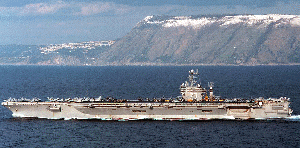|

USS George Washington CVN 73 |
The aircraft
carrier's primary mission is to provide a forward-deployed offense.
It accomplishes this by supporting a composite airwing of some
70-plus multimission-capable aircraft.
Combat capabilities include
surveillance, antisubmarine warfare, antisurface ship warfare, air-to-air
combat, strike warfare, and electronic countermeasures warfare.
Supportive missions, including
medical support of the crew members aboard, are facilitated by a
self-sufficient carrier hospital, which is a 65-bed, level
"2-plus" facility with the following attributes:
-
3
dedicated ICU beds with coinciding equipment
-
1
operating room
-
X-ray
capability (less ultrasound, CAT scan, and most dye imaging)
-
pharmaceutical
service
-
orthopedic
cast room
-
physical
exam service, including refractions/audio tests
-
spectacle
fabricating facility
-
full-service
lab (may have HIV screening);
-
preventive
medicine support
-
dental
support, including oral surgery and prosthetics
Carrier manning includes:
-
a
flight surgeon serving as the senior medical officer
-
a
general surgeon
-
a
nurse anesthetist / anesthesiologist
-
a
general medical officer and usually two flight surgeons attached to
the Airwing
-
a
physician's assistant
-
a
health care administrator
-
a
nurse
-
40
to 45 hospital corpsmen (including those assigned to the Wing) with a
variety of NECs.
The carrier's medical
department also serves as a consultative and primary MEDEVAC facility for
the other vessels within the battle group, which could consist of another
six ships and some 2,000 crewmembers.
Aircraft carriers have excellent medical resources,
including communications, physical facilities, transportation, and medical
staff. Their limitations are:
-
They are not as well equipped for treating large
numbers of casualties as the amphibious assault ships, and
-
During combat, the carrier is focused on air
operations. Trying to transfer casualties to the carrier at this time
may be difficult or impossible.
Approved for public release; Distribution is unlimited.
The listing of any non-Federal product in this CD is not an
endorsement of the product itself, but simply an acknowledgement of the source.
Operational Medicine 2001
Health Care in Military Settings
Bureau of Medicine and Surgery
Department of the Navy
2300 E Street NW
Washington, D.C
20372-5300 |
Operational Medicine
Health Care in Military Settings
CAPT Michael John Hughey, MC, USNR
NAVMED P-5139
January 1, 2001 |
United States Special Operations Command
7701 Tampa Point Blvd.
MacDill AFB, Florida
33621-5323 |
This web version is provided by
The Brookside Associates Medical Education Division.
It contains original contents from the official US Navy NAVMED P-5139, but has
been reformatted for web access and includes advertising and links that were not
present in the original version. This web version has not been approved by the
Department of the Navy or the Department of Defense. The presence of any
advertising on these pages does not constitute an endorsement of that product or
service by either the US Department of Defense or the Brookside Associates. The
Brookside Associates is a private organization, not affiliated with the United
States Department of Defense.
Contact Us · · Other Brookside
Products
|
